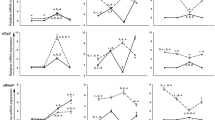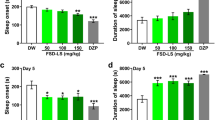Abstract
(1) Circadian clocks have been localized to discrete sites within the nervous system of several organisms and in mammals to the suprachiasmatic nucleus (SCN) in the anterior hypothalamus. The SCN controls and regulates the production and discharge of melatonin (hormonal message of darkness) from the pineal gland via a multisynaptic efferent pathway. The nocturnal rise in melatonin production from serotonin results due to an increased activity of serotonin N-acetyl transferase (NAT). (2) The complex interaction between alcohol and biological clock need to be understood as alcoholism results in various clock linked neuronal disorders especially loss of memory and amnesia like state of consciousness, sleep disorders, insomnia, dementia etc. (3) Serotonin, 5-Hydroxy-tryptamine (5-HT) plays an important role in mediating alcohol’s effects on the brain. Understanding the impact of alcohol consumption on circadian system is a pre-requisite to help in treatment of alcohol induced neurological disorders. We, therefore, studied the effect of ethanol drinking and ethanol withdrawal on daily rhythms of serotonin and its metabolite, 5-hydroxy-indole acetic acid (5-HIAA) in SCN and Pineal of adult male Wistar rats maintained under light-dark (LD, 12:12) conditions. (4) Curcumin is well known for its protective properties such as antioxidant, anti-carcinogenic, anti-viral and anti-infectious etc. Hence, we studied the effect of curcumin on ethanol induced changes on 5-HT and 5-HIAA levels and rhythms in SCN and Pineal. (5) Ethanol withdrawal could not restore either rhythmicity or phases or levels of 5-HT and 5-HIAA. Curcumin administration resulted in partial restoration of daily 5-HT/5-HIAA ratio, with phase shifts in SCN and in Pineal. Understanding the impact of alcohol consumption on circadian system and the role of herbal medication on alcohol withdrawal will help in treatment of alcohol induced neurological disorders.


Similar content being viewed by others
References
Aggarwal BB, Kumar A, Bharti AC (2003) Anticancer potential of curcumin: preclinical and clinical studies. Anticancer Res 23:363–398
Arajuo CC, Leon LL (2001) Biological activities of Curcuma longa L. Mem Inst Oswaldo Cruz 96:723–728
Baird TJ, Briscoe RJ, Vallett M, Vanecek SA, Holloway FA, Gauvin DV (1998) Phase–response curve for ethanol: alterations in circadian rhythms of temperature and activity in rats. Pharmacol Biochem Behav 61:303–315
Barr SI (1988) Influence of increasing concentrations of ethanol on food and water intake, body weight and wheel running activity of male Sprague-Dawley rats. Pharmacol Biochem Behav 29:667–673
Bradford M (1976) A rapid and sensitive method for the quantitation of microgram quantities of protein utilizing the principle protein-dye binding. Anal Biochem 72:248–254
Carmichael FJ, Israel Y (1975) Effects of ethanol on neurotransmitter release by rat brain cortical slices. J Pharmacol Exp Ther 193:824–834
Chen CP, Kuhn P, Advis JP, Sarkar DK (2004) Chronic ethanol consumption impairs the circadian rhythm of pro-opiomelanocortin and period genes mRNA expression in the hypothalamus of the male rat. J Neurochem 88:1547–1554
Dahchour A, Quertemont E, De Witte P (1994) Acute ethanol increases taurine but neither glutamate nor GABA in the nucleus accumbens of male rats: a micro dialysis study. Alcohol Alcohol 29:485–487
Danel T, Touiton Y (2006) Alcohol consumption does not effect melatonin circadian synchronization in healthy men. Alcohol Alcohol 41:386–390
Ehlers CL, Slawecki CJ (2000) Effects of chronic ethanol exposure on sleep in rats. Alcohol 20:173–179
El-Mas MM, Abdel-Rahman AA (2000) Radio telemetric evaluation of homodynamic effects of long-term ethanol in spontaneously hypertensive and Wistar-Kyoto rats. J Pharmacol Exp Therapeut 292:944–951
Fonzi S, Solinas GP, Costelli P, Parodi C, Murialdo G, Bo P, Albergati A, Montalbetti L, Savoldi F, Polleri A (1994) Melatonin and cortisol circadian secretion during ethanol withdrawal in chronic alcoholics. Chronobiologia 21:109–112
Gewiss M, Heidbreder C, Opsomer L, Durbin P, De Witte P (1991) Acamprosate and diazepam differentially modulate alcohol-induced behavioral and cortical alterations in rats following chronic inhalation of ethanol vapor. Alcohol Alcohol 26:129–137
Glue P, Nutt D (1990) Overexcitement and disinhibition. Dynamic neurotransmitter interactions in alcohol withdrawal. Br J Psychiatry 157:491–499
Grady RK, Caliguri JA, Mefford IN (1984) Day/night differences in pineal indoles in the adult pigeon (Columba livia). Comp Biochem Physiol 78:141–143
Grant KA, Valverius P, Hudspith M, Tabakoff B (1990) Ethanol withdrawal seizures & the NMDA receptor complex. Eur J Pharmacol 176:289–296
Imatoh N, Nakazawa Y, Ohshima H, Ishibashi M, Yokoyama T (1986) Circadian rhythm of REM sleep of chronic alcoholics during alcohol withdrawal. Drug Alcohol Depend 18:77–85
Iranmanesh A, Veldhuis JD, Johnson ML, Lizarralde G (1989) 24-hour pulsatile and circadian patterns of cortisol secretion in alcoholic men. J Androl 10:54–63
Jagota A (2005) Aging and sleep disorders. Indian J Gerontol 19:415–424
Jagota A (2006) Suprachiasmatic nucleus: the center for circadian timing system in mammals. Proc Indian Natl Sci Acad B71:275–288
Jagota A, de la Iglesia HO, Schwartz WJ (2000) Morning and evening circadian oscillations in the suprachiasmatic nucleus in vitro. Nat Neurosci 3:372–376
Joe B, Vijay Kumar M, Lokesh BR (2004) Biological properties of curcumin – cellular and molecular mechanisms of action. Crit Rev Food Sci Nutr 44:97–111
Kawahara F, Saito H, Katsuki H (1993) Pharmacological characteristics of GABAa responses in post natal suprachiasmatic neurons in culture. Neurosci Lett 160:45–48
Klein DC, Coon SL, Roseboom PH, Weller JL, Bernard M, Gastel JA, Zatz M, Iuvone PM, Rodriguez IR, Bégay V, Falcón J, Cahill GM, Cassone VM, Baler R (1997) The melatonin rhythm generating enzyme: molecular regulation of serotonin N-acetyl transferase in the pineal gland. Recent Prog Horm Res 52:307–358
Klein DC, Moore RY, Reppert SM (1991) Suprachiasmatic nucleus: the mind’s clock. Oxford University Press, New York
Kodama H, Nakazawa Y, Kotorii T, Nonaka K, Inanaga K, Ohshima M, Tokoyama T (1988) Biorhythm of core temperature in depressive and non-depressive alcoholics. Drug Alcohol Depend 21:1–6
LeMarquand D, Pihl RO, Benkelfat C (1994) Serotonin and alcohol intake, abuse, and dependence: findings of animal studies. Biol Psychiatry 36:395–421
Littleton J (1998) Neurochemical mechanisms underlying alcohol withdrawal. Alcohol Health Res World 22:13–24
Lovinger DM (1999) The role of serotonin in alcohol’s effects on the brain. Curr Sep 18:23–28
Madeira MD, Paul-Barbosa MM (1999) Effect of alcohol on the synthesis and expression of hypothalamic peptides. Brain Res Bull 48:3–22
Mefford IN, Chang P, Klein DC, Namboodiri MAA, Sugden D, Barchas J (1980) Determination of tryptophan and metabolites in rat brain and pineal tissue by reversed-phase high-performance liquid chromatography with electrochemical detection. J Chromatogr 181:187–193
Michaelis EK, Mulvaney MJ, Freed WJ (1978) Effects of acute and chronic ethanol intake on synaptosomal lutamate binding activity. Biochem Pharmacol 27:1685–1691
Mistleberger RE, Nadeau J (1992) Ethanol and circadian rhythms in Syrian hamster: effects on entrained phase, reentrainment rate and period. Pharmacol Biochem Behav 43:159–165
Mistleberger RE, Antle MC, Glass JD, Miller JD (2000) Behavioral and serotonergic regulation of circadian rhythms. Biol Rhythm Res 31:240–283
Moore RY (1991) Suprachiasmatic nucleus. In: Klein DC, Moore RY, Reppert SM (eds) Disorders of circadian function and the human circadian timing system. Oxford University Press, New York, pp 429–441
Morin LP (1999) Serotonin and the regulation of mammalian circadian rhythmicity. Ann Med 31:12–33
Moyer RW, Kennaway DJ (1999) Immunohistochemical localization of serotonin receptors in the rat suprachiasmatic nucleus. Neurosci Lett 271:147–150
Mukai M, Uchimura N, Hirano T, Ohshima H, Ohshima M, Nakamura J (1998) Circadian rhythms of hormone concentration in alcohol withdrawal. Psychiatry Clin Neurosci 52:238–240
Oncken C, Van Kirk J, Kranzler HR (2001) Adverse effects of oral naltrexone: analysis of data from two clinical trials. Psychopharmacology 154:397–402
Oscar MA, Bataillon C, Bagheri H, Le Quellec A, Rolland F, Montastruc JL (2003) Acamprosate (Aotal): could adverse effects upset the treatment of alcohol dependence? Therapie 58:371–374
Petrakis I, Krystal J (1997) Neuroscience implications for treatment. Alcohol Health Res world 21:177–179
Prospero G, Criado JR, Henriksen SJ (1994) Pharmacology of ethanol and glutamate antagonists on rodent sleep. A comparative study. Pharmacol Biochem Behav 49:413–416
Prosser RA, Gillette MU (1989) The mammalian circadian clock in the suprachiasmatic nuclei is reset in vitro by cAMP. J Neurosci 9:1073–1081
Rajakrishnan V, Subramanian P, Viswanathan P, Menon VP (1999) Effect of chronic ethanol ingestion on biochemical circadian rhythms in Wistar rats. Alcohol 18:147–152
Rea MA, Pickard GE (2000) Serotonergic modulation of the photic entrainment in the Syrian hamster. Biol Rhythm Res 31:284–314
Sano H, Suzuki Y, Yazaki R, Tamefusa K, Ohara K, Yokoyama T, Miyasato K, Ohara K (1993) Circadian variation in plasma 5-HIAA level during and after alcohol withdrawal. Acta Psychiatr Scand 87:291–296
Sano H, Suzuki Y, Ohara K, Miyasato K, Yokoyama T, Ohara K (1994) Circadian variations in plasma monoamine metabolites level in alcoholic patients: a possible predictor of alcohol withdrawal delirium. Prog Neuro-psychopharmacol Biol Psychiatry 18:741–752
Spanagel R, Rosenwasser AM, Shumann G, Sarkar DK (2005) Alcohol consumption and the body’s clock. Alcohol Clin Exp Res 29:1550–1557
Tabakoff B, Hoffman PL (1996) Alcohol addiction: an enigma among us. Neuron 16:909–912
Valenuzuela CF, Harris RA (1997) Alcohol: neurobiology. In: Lowinson JH, Ruiz P, Millman RB, Langrod JG (eds) Substance abuse: a comprehensive textbook. Williams & Wilkins, Baltimore, pp 112–142
Verge C, Lucena MI, López-Torres E, Puche-Garcia MJ, Fraga E, Romero-Gomez M, Andrade RJ (2006) Adverse hepatic reactions associated with calcium carbimide and disulfiram therapy: is there still a role for these drugs? World J Gastroenterol 12:5078–5080
Yoshimoto K, McBride WJ, Lumeng L, Li TK (1992) Alcohol stimulates the release of dopamine and serotonin in the nucleus accumbens. Alcohol 9:17–22
Zarcone V (1978) Alcoholism and sleep. Adv Biosci 21:29–38
Acknowledgements
This work supported by research grants from ILS (EFL/II/CS-MoU/112/1872 dt. 14.12.2004) and DST (Do No: SR/SO/AS-47/2004) to A.J. CSIR fellowship to M.Y. Reddy is acknowledged.
Author information
Authors and Affiliations
Corresponding author
Rights and permissions
About this article
Cite this article
Jagota, A., Reddy, M.Y. The Effect of Curcumin on Ethanol Induced Changes in Suprachiasmatic Nucleus (SCN) and Pineal. Cell Mol Neurobiol 27, 997–1006 (2007). https://doi.org/10.1007/s10571-007-9203-8
Received:
Accepted:
Published:
Issue Date:
DOI: https://doi.org/10.1007/s10571-007-9203-8




